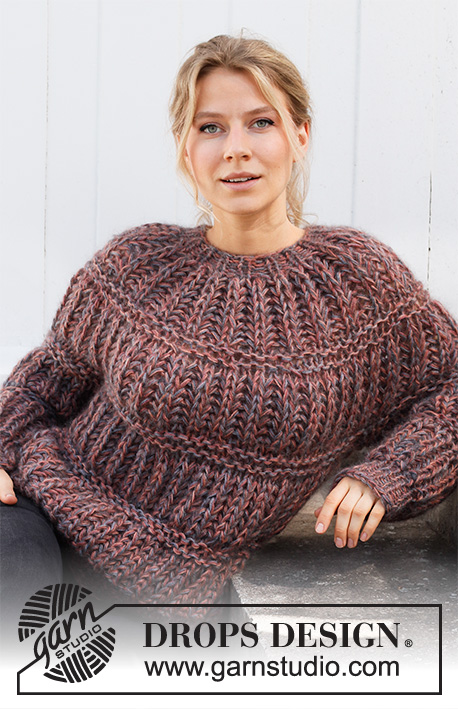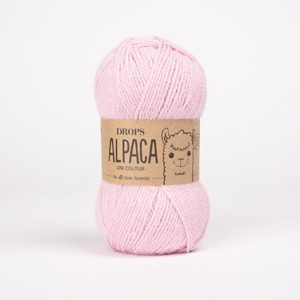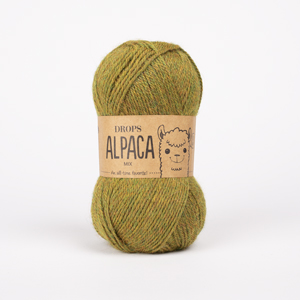Comments / Questions (5)
![]() Sanne Jensen wrote:
Sanne Jensen wrote:
Det er ikke lykkedes mig at finde Drops Alpaca i farven 8120, lavendel mix - er den udgået? Hvis det er tilfældet, hvilken farve (eller evt. andet garn) kan jeg erstatte den med for at få nogenlunde samme farvespil?
13.07.2022 - 13:32DROPS Design answered:
Hej Sanne. Ja den har dessvärre utgått. Du kan använda t.ex. färg 4434 istället. Mvh DROPS Design
13.07.2022 - 13:42
![]() Lena Grøvdal wrote:
Lena Grøvdal wrote:
Men da burde dere skrevet det i oppskriften. Etter første helpatent så skriver dere strikk A1 , dere skriver ikke at man skal strikke sammen kastene..
04.03.2021 - 08:28
![]() Lena Grøvdal wrote:
Lena Grøvdal wrote:
Hei. Det er noe feil med oppskriften. Dere skriver man skal øke i A1, men når man strikker helpatent så blir det jo økt automatisk. Jeg har jo flere masker i smal str enn det dere skriver....
03.03.2021 - 13:54DROPS Design answered:
Hei Lena, Mens du strikker helpatent skal antall masker bli det samme (ingen økninger). Du lager kast den ene omgangen og strikke dem sammen med rett masken omgangen etter. Så du skal bare øke i A.1 der det står spesifisert i diagrammet. Håper dette hjelper og god fornøyelse!
04.03.2021 - 07:51
![]() María Jesús Alonso Abalde Alonso Abalde wrote:
María Jesús Alonso Abalde Alonso Abalde wrote:
Me parece muy elegante y diferente
07.08.2020 - 20:56
![]() Novella wrote:
Novella wrote:
Bonbon
17.07.2020 - 23:10
Tundra Twilight#tundratwilightsweater |
|||||||
 |
 |
||||||
Knitted sweater in 3 strands DROPS Alpaca and 3 strands DROPS Kid-Silk. Piece is knitted top down with English rib and round yoke. Size: S - XXXL
DROPS 218-8 |
|||||||
|
------------------------------------------------------- EXPLANATION FOR THE PATTERN: ------------------------------------------------------- INCREASE TIP (evenly): To calculate how to increase evenly, use the total number of stitches on row (e.g. 36 stitches) and divide stitches by number of increases to be done (e.g. 18) = 2. In this example increase by making 1 yarn over after every other stitch (work yarn overs somewhat tight to avoid big holes). On next round work yarn overs twisted to avoid holes. ENGLISH RIB (worked in the round): ROUND 1: * Knit 1, make 1 yarn over, slip 1 stitch purlwise *, work from *-* the rest of round. ROUND 2: * Make 1 yarn over, slip 1 stitch purlwise, purl together yarn over and slipped stitch *, repeat from *-* the rest of round. ROUND 3: * Knit together yarn over and slipped stitch, 1 yarn over, slip 1 stitch purlwise *, repeat from *-* the rest of round. Repeat rounds 2 to 3. PATTERN: See diagram A.1. DECREASE TIP (applies to mid under sleeves): All decreases are done on a round with English rib where yarn over and knit stitch are knitted together (adjust to decrease in sections with English rib). DECREASE 2 STITCHES TOWARDS THE RIGHT AS FOLLOWS (i.e. begin 3 stitches + 2 yarn overs before purl stitch with marker): Slip first knit stitch and yarn over loosely on to right needle knitwise, purl 1, pass slipped stitch and yarn over over purl stitch, slip stitch back on left needle, pass slipped stitch and yarn over over stitch place back on left needle, slip the remaining stitch over on to right needle (= 2 stitches decreased). DECREASE 2 STITCHES TOWARDS THE LEFT AS FOLLOWS (i.e. begin right after purl stitch with marker): Slip first knit stitch and yarn over on to right needle knitwise, knit the next 2 stitches together (i.e. 1 purl + knit stitch and yarn over), then slip the loose stitch and yarn over over stitches worked together (= 2 stitches decreased). BIND-OFF TIP: To avoid a tight bind-off edge you may use a larger needle size. If this also is too tight, work a 1 yarn over after approx. every 4th stitch while binding off (bind off yarn overs as regular stitches). ------------------------------------------------------- START THE PIECE HERE: ------------------------------------------------------- SWEATER - SHORT OVERVIEW OF THE PIECE: Neck edge and yoke are worked in the round on double pointed needles/circular needle from right shoulder at the back, top down. Yoke is divided into body and sleeves. Body is worked in the round on circular needle, top down. Sleeves are worked in the round on double pointed needles, top down. NOTE! All number of stitches given when working English rib is without yarn overs because yarn overs are counted as 1 stitch together with the slipped stitch. NECK EDGE: Cast on 36-36-38-40-42-44 stitches on double pointed needles size 9 mm = US 13 with 1 strand of each color and quality (= 6 strands). Work rib in the round = knit 1/purl 1 for 3-3-3-4-4-4 cm = 1⅛"-1⅛"-1⅛"-1¼"-1¼"-1¼". When rib is done, knit 1 round while increasing 18-18-20-20-22-22 stitches evenly - read INCREASE TIP = 54-54-58-60-64-66 stitches. Switch to double pointed needles or circular needle size 12 mm = US 17. Insert 1 marker at beginning of round. Work yoke as explained below. Measure yoke from this marker. YOKE: Work ENGLISH RIB - read explanation above. REMEMBER THE KNITTING GAUGE! When piece measures 8-8-9-10-11-12 cm = 3⅛"-3⅛"-3½"-4"-4⅜"-4¾" from marker after neck edge, work A.1 in the round (A.1 = approx. 4 cm = 1½" vertically). AT THE SAME TIME on first round in A.1 increase 28-28-30-30-32-34 stitches evenly = 82-82-88-90-96-100 stitches, and on last round in A.1 increase 18-22-24-24-28-30 stitches evenly = 100-104-112-114-124-130 stitches. When A.1 has been worked, work English rib (begin with 1st round, then repeat 2nd and 3rd round as before). When piece measures 20-21-22-24-26-28 cm = 8"-8¼"-8¾"-9½"-10¼"-11" from marker, work A.1 in the round. AT THE SAME TIME on first round increase 0-6-8-12-16-22 stitches evenly = 100-110-120-126-140-152 stitches. When yoke measures 21-23-24-26-28-30 cm = 8¼"-9"-9½"-10¼"-11"-11¾" from marker, divide yoke for body and sleeves as explained below (if the measurements are maintained, a few rounds remain in A.1 when the piece is divided – work rest of A.1 on body and sleeves). Divide yoke as follows: Slip the first 21-23-25-27-29-31 stitches on 1 stitch holder, cast on 5-5-5-7-7-7 new stitches on needle (= in the side under sleeve) work A.1 over the next 29-32-35-36-41-45 stitches (= front piece), slip the next 21-23-25-27-29-31 stitches on 1 stitch holder for sleeve, cast on 5-5-5-7-7-7 new stitches on needle (= in the side under sleeve), and work A.1 as before over the next 29-32-35-36-41-45 stitches (= back piece). Cut the yarn. Finish body and sleeves separately. BODY: = 68-74-80-86-96-104 stitches. Begin round in the middle of the 5-5-5-7-7-7 stitches that were cast on under one sleeve, and finish A.1. Work English rib as before for 9-9-10-10-11-12 cm = 3½"-3½"-4"-4"-4⅜"-4¾". Work A.1. Then work English rib as before for approx. 9-10-10-10-11-12 cm = 3½"-4"-4"-4"-4⅜"-4¾" - finish with round 2 in English rib pattern. Piece now measures approx. 25-25-26-26-28-30 cm = 9¾"-9¾"-10¼"-10¼"-11"-11¾" from division and approx. 6 cm = 2⅜" remain until finished measurements. Now you can try the sweater and work to desired length, but make sure to finish with working round 2 in English rib pattern. Switch to circular needle size 9 mm = US 13. Work rib in the round (= knit 1/purl 1) but adjust so that rib fits nicely over pattern in English rib - on first round rib knit yarn overs from English rib stitches together with knit stitches in rib. Continue rib with knit over knit and purl over purl in the round for 6 cm = 2⅜". Bind off with knit over knit and purl over purl - read BIND-OFF TIP. Sweater measures approx. 56-58-60-62-66-70 cm = 22"-22¾"-23⅝"-24⅜"-26"-27½" from shoulder and down. SLEEVE: Slip the 21-23-25-27-29-31 stitches from stitch holder in one side of piece on double pointed needles size 12 mm = US 17 and pick in addition up 1 stitch in each of the 5-5-5-7-7-7 new stitches cast on under sleeve = 26-28-30-34-36-38 stitches. Read the rest of sleeve before continuing! Insert 1 marker in the middle of the 5-5-5-7-7-7 stitches under sleeve. Move marker upwards when working. Use marker later when decreasing mid under sleeve. Begin round after stitch with marker (i.e. stitch with marker is now last stitch on round). Finish A.1 the same way as on body. Then work English rib in the round for 9-9-10-10-11-12 cm = 3½"-3½"-4"-4"-4⅜"-4¾". Then work A.1 in the round. When A.1 has been worked, work English rib until finished measurements before rib at the bottom of sleeve. AT THE SAME TIME when sleeve measures 3 cm = 1⅛" from division, decrease 2 stitches towards the right mid under sleeve (decrease 2 stitches before stitch with marker) - read DECREASE TIP = 24-26-28-32-34-36 stitches. When sleeve measures 7-7-6-6-5-5 cm = 2¾"-2¾"-2⅜"-2⅜"-2"-2" from division, decrease 2 stitches towards the left mid under sleeve (decrease 2 stitches after stitch with marker) = 22-24-26-30-32-34 stitches. Decrease like this every 6-6-5-5-4-4 cm = 2⅜"-2⅜"-2"-2"-1½"-1½" until 2 stitches have been decreased 4-4-5-6-7-8 times in total mid under sleeve= 18-20-20-22-22-22 stitches remain. Work English rib until sleeve measures approx. 38-37-37-34-32-31 cm = 15"-14½"-14½"-13⅜"-12½"-12¼" from division. Approx. 6 cm = 2⅜" remain until finished measurements, try the sweater on and work until desired length. NOTE! Shorter measurements in the larger sizes because of wider neck and longer yoke. Switch to double pointed needles size 9 mm = US 13. Work rib in the round the same way as bottom on body. When rib measures 6 cm = 2⅜", bind off with knit over knit and purl over purl - remember BIND-OFF TIP! Sleeve measures approx. 44-43-43-40-38-37 cm = 17¼"-17"-17"-15¾"-15"-14½" from division. Work the other sleeve the same way. |
|||||||
Diagram explanations |
|||||||
|
|||||||

|
|||||||
Have you finished this pattern?Tag your pictures with #dropspattern #tundratwilightsweater or submit them to the #dropsfan gallery. Do you need help with this pattern?You'll find 22 tutorial videos, a Comments/Questions area and more by visiting the pattern on garnstudio.com. © 1982-2025 DROPS Design A/S. We reserve all rights. This document, including all its sub-sections, has copyrights. Read more about what you can do with our patterns at the bottom of each pattern on our site. |
|||||||





































































Post a comment to pattern DROPS 218-8
We would love to hear what you have to say about this pattern!
If you want to leave a question, please make sure you select the correct category in the form below, to speed up the answering process. Required fields are marked *.